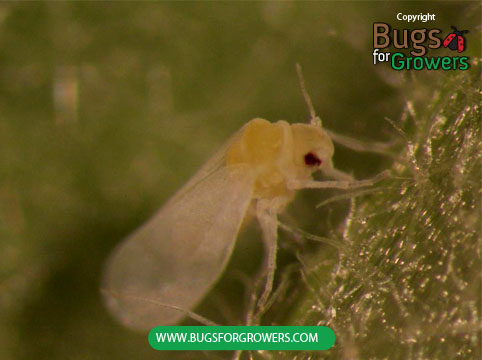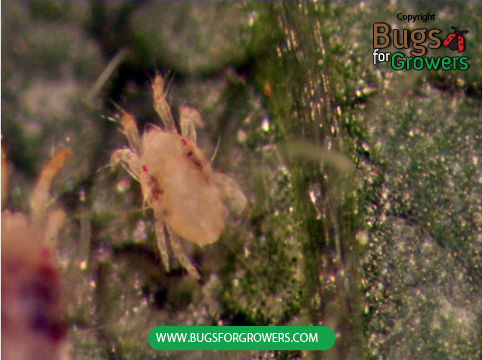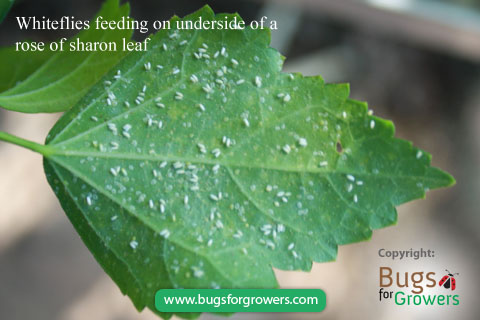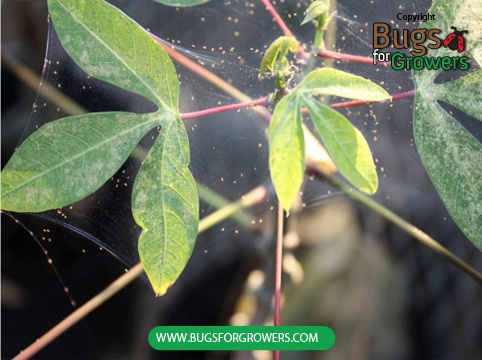Whiteflies and two-spotted spider mites
When vegetables or ornamentals are grown in the greenhouse, they are simultaneously attacked by two most economically important pests like greenhouse whiteflies, Trialeurodes vaporariorum (Photo 1) and two-spotted spider mites,Tetranychus urticae (Photo 2). This poses a serious challenge to control both of these pests at the same time using a single chemical pesticide because these two pests are taxonomically and physiologically different from each other and therefore, they can react differently to specific pesticides.


Also, the use of chemical pesticides are currently restricted in the greenhouses because of their detrimental effects on humans and the environment. Therefore, the best option to control both the whiteflies and spider mites simultaneously in the greenhouses is to release beneficial predatory mite, Amblyseius swirskii because they are easy to release, do not cause any harm to either humans or the environment and most importantly, they can feed on both the whiteflies and spider mites simultaneously.
Damage caused by greenhouse whiteflies
Both the mature and immature stages of greenhouse whiteflies cause damage to the leaves of many vegetables, ornamental plants grown in the greenhouses. Whiteflies generally suck juice from the underside of leaves by using their piercing and sucking types of mouthparts (Photo 3). This type of feeding damage generally causes yellowing and drying of leaves. While feeding, whiteflies also secrete honeydew that stimulates the growth of black sooty mold on the surface of leaves. This black sooty mold affects the process of photosynthesis, reduces the quality of the produce and aesthetic value of many ornamental plants. Whiteflies also transmit different types of plant viruses that can reduce yields of many vegetables and the quality of ornamentals.

Damage caused by two-spotted spider mites
Two-spotted spider mites suck juice from leaves, succulent twigs and stems of many economically important crops like cucumber, eggplant, pepper, strawberries and tomatoes. Heavily infested leaves become yellow, mottled and speckled. Severely speckled leaves also affect the process of photosynthesis that in turn reduces plant’s ability to make its own food. Severely infested leaves dry and drop off the plants prematurally that leads to sever yield loss or the plant death. Furthermore, spider mites also produce webbing on the leaves and small branches with the fine strands (Photo 4) that reduces aesthetic value of many ornamentals such as azalea, camellia, hollies, ligustrum, roses and viburnum. Thus the damage caused by two-spotted spider mites can cause in millions of dollars loss to greenhouse industry.

What are predatory Amblyseius swirskii mites?
Amblyseius swirskii are pear-shaped tiny predatory mites with four pairs of legs. Both adults and nymphs of these mites feed on the different stages of both the whiteflies and two-spotted spider mites.
How predatory Amblyseius swirskii mites can control whiteflies and two-spotted spider mites?
Amblyseius swirskii mites are commercially available as mixed stages of adults and larvae. When these mites are released in the greenhouse, they quickly disperse quickly in the greenhouses and seek their hosts including different stages of whiteflies and two-spotted spider mites and start feeding voraciously on them and eliminate their populations quickly and simultaneously in the greenhouses.
How many Amblyseius swirskii mites should be released?
For the effective control of whiteflies and two-spotted spider mites, release over 5000 Amblyseius swirskii mites per acre 2-3 times on a bi-weekly basis. These warm adapted predatory mites perform better when they are released at optimum temperature mentioned above but their activity will reduce if released at temperature lower than 20°C (68°F). These mites will not survive if they are released at really cold and frosty temperatures.
